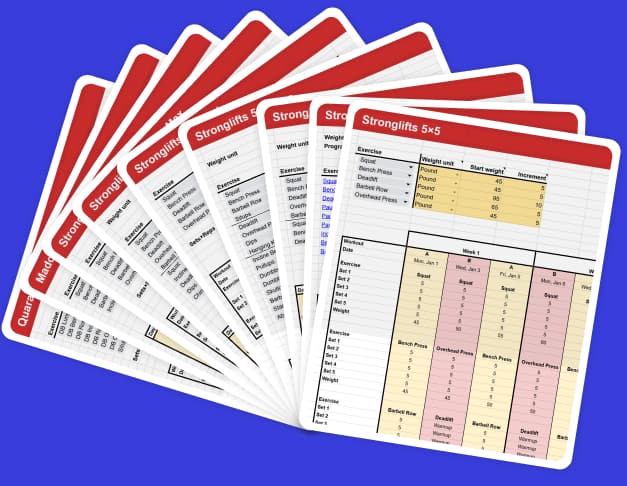Stronglifts 5×5 Ultra is an upper/lower body workout split for building strength and muscle. It’s a four-day variation of Stronglifts 5×5 in which you train your upper and lower body in separate workouts. One day you do exercises for your lower body. The next day you train your upper body. A five day version of the program is also available if you have time to do more.
Stronglifts 5×5 Ultra has shorter workouts compared to Stronglifts 5×5. This can be helpful if your Stronglifts 5×5 workouts are becoming too long because you’re now lifting much heavier weights than when you started. It’s also easier to add assistance work to build extra muscle with Stronglifts 5×5 Ultra.
Let me show you how Stronglifts 5×5 Ultra works.
Contents
- What is Stronglifts 5×5 Ultra Upper/lower Split?
- Workout Schedule of Stronglifts 5×5 Ultra
- Sets & Reps with Stronglifts 5×5 Ultra
- Muscles Worked with Stronglifts 5×5 Ultra
- Weekly Training volume of Stronglifts 5×5 Ultra
- How Stronglifts 5×5 Ultra came to be
- Stronglifts 5×5 Ultra vs Stronglifts 5×5
- Stronglifts 5×5 Ultra FAQs
- What are the benefits of upper/lower splits?
- What are the drawbacks of upper/lower splits?
- Are upper/lower splits better for recovery?
- Who is Stronglifts 5×5 Ultra for?
- Who is Stronglifts 5×5 Ultra not for?
- Should I start the week with upper or lower body?
- Can I rest between the lower and upper body days?
- Can I do upper lower 2×/week?
- Can I do upper lower 3×/week?
- Can I do upper lower 5×/week?
- How to progress?
- How long should I rest between sets?
- Are upper lower splits good for beginners?
- Why only 1×5 Deadlifts after 5×5 Squats?
- Why abs in the lower body workout?
- Do upper/lower splits build more muscle?
- Is Upper/lower or full body best?
- Is there a spreadsheet for Stronglifts 5×5 Ultra?
- References
Join the Stronglifts community to get free access to all the spreadsheets for every Stronglifts program. You’ll also get 17% off Stronglifts Pro, and daily email tips. Enter your email below to sign up today for free.
What is Stronglifts 5×5 Ultra Upper/lower Split?
Stronglifts 5×5 Ultra is a four-day upper/lower workout split in which you train your upper and lower body on different days. In workouts A and C you train your lower body with Squats and Deadlifts. In workouts B and D you train your upper body with the Bench Press, Overhead Press and Barbell Rows.
Stronglifts 5×5 Ultra consists of four workouts A, B, C and D. You do four workouts a week, alternating lower and upper body workouts. You train your lower and upper body on two consecutive days before taking a rest day.
| Stronglifts 5×5 Ultra: upper/lower split | |||
|---|---|---|---|
| Workout A | Workout B | Workout C | Workout D |
| Squat 5×5 | Bench Press 5×5 | Deadlift 5×5 | Overhead Press 5×5 |
| Deadlift 1×5 | Barbell Row 5×5 | Squat 1×5 | Bench Press 5×5 |
| Assistance work | Assistance work | Assistance work | Assistance work |
5×5 means five sets of five reps with the same weight. 1×5 means one heavy set of five reps after you do your warmup sets. There’s optional assistance work that you can add to each workout if you have time for more and want to do more volume to build extra muscle. I’ll explain this below.
You can log Stronglifts 5×5 Ultra using the Stronglifts app. Tap the program tab at the bottom and then select Stronglifts 5×5 Ultra from the list. You’ll find several templates with different exercises and options for Assistance Work. You can easily replace exercises if you want.
Workout Schedule of Stronglifts 5×5 Ultra
With Stronglifts 5×5 Ultra you do four workouts a week. You alternate two lower and upper body workouts. Like this…
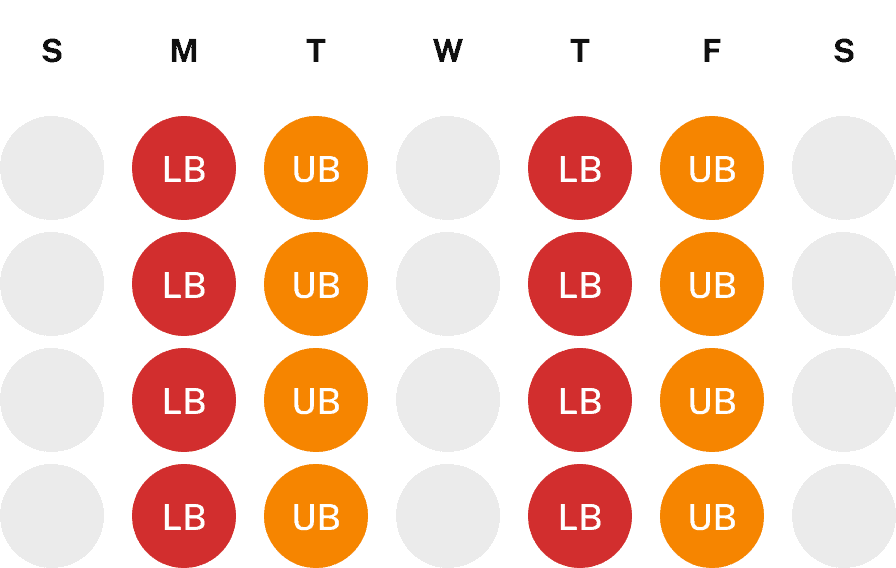
The most common schedule is Monday, Tuesday, Thursday and Friday. You train your lower and upper body two days in a row before taking a day off.
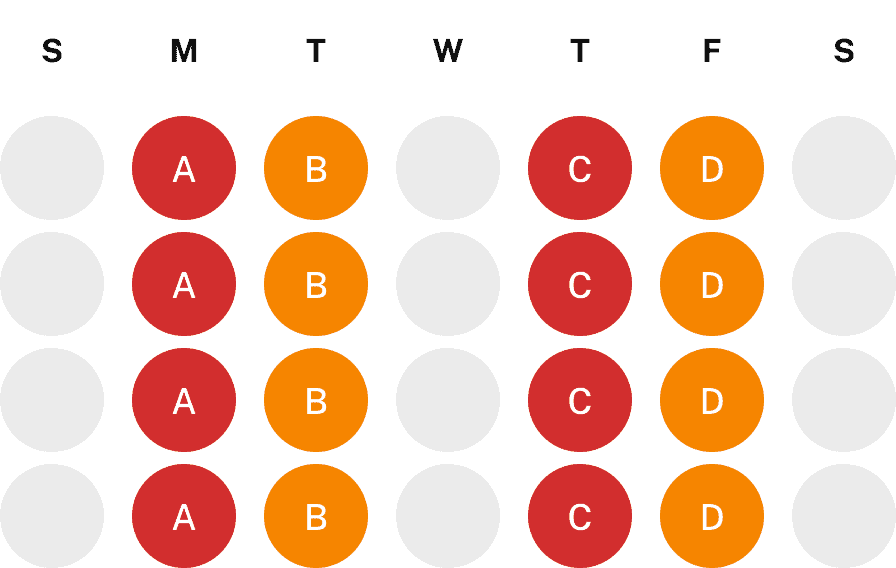
This is the schedule I recommend for Stronglifts 5×5 Ultra. It’s how I’ve always had the best result with upper/lower body splits. You do the harder lower body workout right after the weekend when you had two days rest. You follow that with the easier upper body workout the next day. Then you take a day off and repeat. Weekends are off to recover physically and mentally.
An alternative workout schedule for Stronglifts 5×5 Ultra is to take a day off after three out of the four workouts. You then only need to train back-to-back once a week instead of twice. Here’s an example…
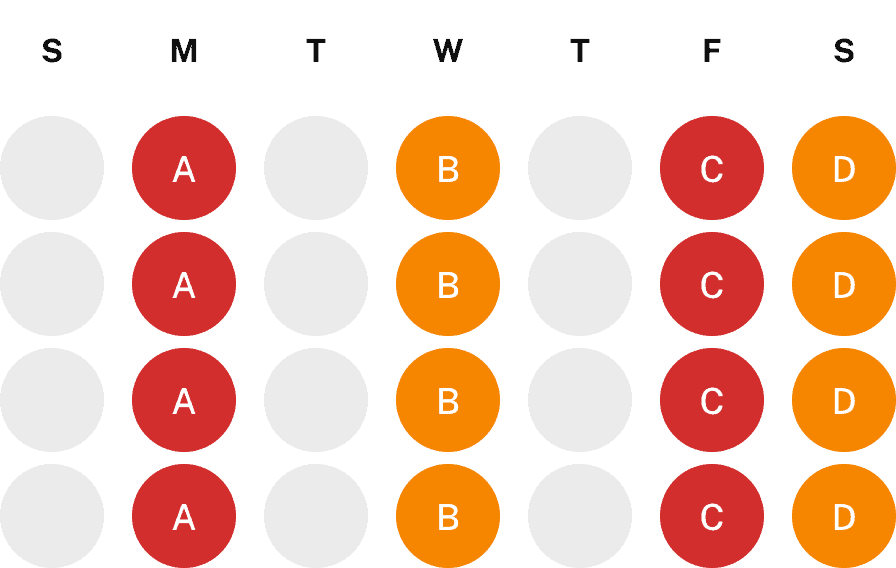
Some say that this second workout schedule is better for recovery. But studies comparing back-to-back workouts to resting for 48 hours found no difference (1, 2, 3). Plus in these studies they used full body workouts. Stronglifts 5×5 Ultra is an upper/lower body workout split. Your legs get a break while you work your upper body the next day. Your recovery is therefore even better than when doing back-to-back full body workouts.
You can set both schedules in the Stronglifts app with the days that you prefer. Once set, the app will alternate between workouts A, B, C and D for you. It will remember what you did and automatically adjust your weights. You can focus on lifting while we do all the thinking.
Sets & Reps with Stronglifts 5×5 Ultra
On Stronglifts 5×5 Ultra you do 5×5 on almost all the main lifts. That means five sets of five reps with the same weight after you complete your warmup sets for that exercise. Let’s say you have to Bench Press 200lb for 5×5 in workout B. Here’s how this would look like…
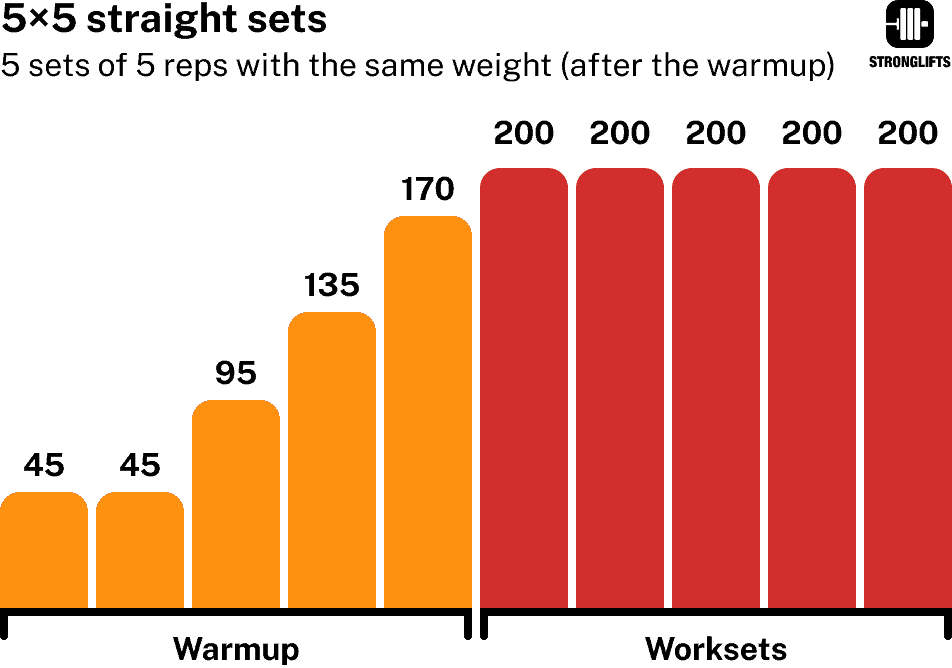
Once the weights become heavier you can switch to top/back-off sets – one heavy top set of five reps, followed by four lighter back-off sets of five reps. The back-off set should be about 10% lighter than your top set.
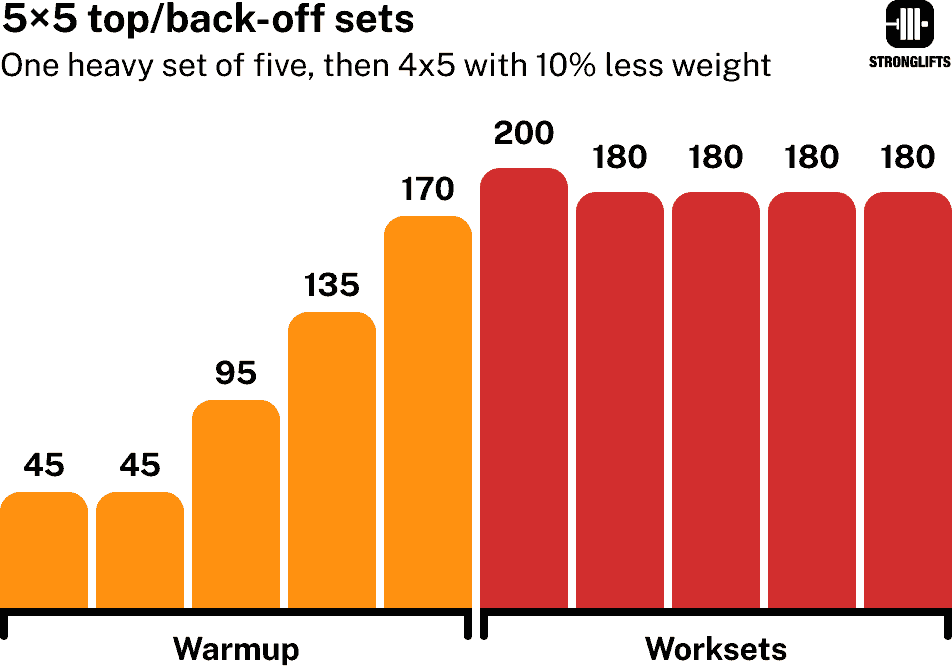
The strength and muscle gains are the same when doing top/back-off sets. But the workouts are less tiring, shorter, and you’re less likely to fail reps. This helps you to keep adding weight on the bar over time. For more information, please read the guide on top/back-off sets.
Muscles Worked with Stronglifts 5×5 Ultra
Stronglifts 5×5 Ultra is an upper/lower body workout split to build strength and muscle. You alternate workouts in which you do exercises for your lower and upper body. Here’s how Stronglifts 5×5 Ultra works your main muscles…
| Stronglifts 5×5 Ultra Muscles Worked | |||
|---|---|---|---|
| Workout A | Workout B | Workout C | Workout D |
| Quads/Glutes Squat | Chest/Shoulders/Triceps Bench Press | Hams/Glutes Deadlift | Shoulders/Triceps Overhead Press |
| Hams/Glutes Deadlift | Back/Biceps Barbell Row | Quads/Glutes Squat | Chest/Shoulders/Triceps Bench Press |
The main exercises of Stronglifts 5×5 Ultra are compounds that work several muscles at the same time. You can extend the program with assistance work and isolation for your chest, back and abs. Example…
| Stronglifts 5×5 Ultra + Assistance Work: Muscles Worked | |||
|---|---|---|---|
| Workout A | Workout B | Workout C | Workout D |
| Quads/Glutes Squat | Chest/Shoulders/Triceps Bench Press | Hams/Glutes Deadlift | Shoulders/Triceps Overhead Press |
| Hams/Glutes Deadlift | Back/Biceps Barbell Row | Quads/Glutes Squat | Chest/Shoulders/Triceps Bench Press |
| Quads/Glutes Lunges | Chest/Shoulders/Triceps Dips | Hams/Glutes Romanian DL | Back/Biceps Pullups |
| Abs Hanging Leg Raises | Biceps Barbell Curls | Abs Planks | Triceps Skullcrushers |
You can find several options for assistance work in the Stronglifts app. Tap program, select Stronglifts 5×5 Ultra, pick a template, select assistance work (this is optional, you can do just the main lifts if you’re short on time).
Weekly Training volume of Stronglifts 5×5 Ultra
Your training volume is how many weekly sets you do for each muscle group or movement (4, 5). Doing more volume typically results in more strength and muscle gains (4, 5, 6). Adding weight over time is the main driver of muscle growth (7, 8, 9). But you also need to do enough weekly sets.
Here’s the weekly training volume that you do with Stronglifts 5×5 Ultra if you only do the main lifts (two compound exercises per workout):
| Muscle | Sets/week | Exercise |
|---|---|---|
| Chest | 10 | Bench Press (2x) |
| Back | 11 | Barbell Row, Deadlift (2x) |
| Shoulders | 15 | Overhead Press, Bench Press (2x) |
| Triceps | 15 | Overhead Press, Bench Press (2x) |
| Biceps | 5 | Barbell Row |
| Legs | 12 | Squat (2x), Deadlift (2x) |
For hypertrophy, 10-20 weekly sets per muscle is recommended (5, 6, 10, 11, 12). A study by Schoenfeld et al found that doing ten sets per week or more results in about 20% more muscle gain compared to 5-9 weekly sets (5).
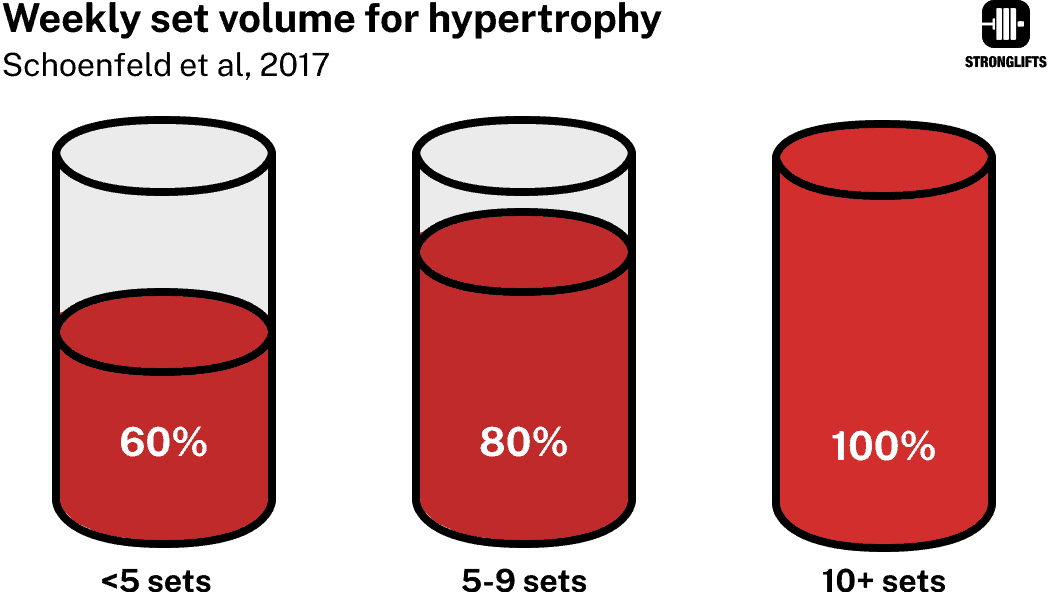
With Stronglifts 5×5 Ultra you do ten sets per week for every muscle except the Biceps. If you have time and energy for more, you can extend the program with assistance work. Say you add Pullups, Curls, Dips and Skullcrushers to workouts B and D. Here’s how the volume then looks like…
| Muscle | Sets/week | Exercise |
|---|---|---|
| Chest | 13 | Bench Press (2x), Dips |
| Back | 14 | Barbell Row, Deadlift (2x), Pullups |
| Shoulders | 18 | Overhead Press, Bench Press (2x), Dips |
| Triceps | 21 | Overhead Press, Bench Press (2x), Dips, Skullcrushers |
| Biceps | 11 | Barbell Row, Pullups, Biceps Curls |
| Legs | 12 | Squat (2x), Deadlift (2x) |
63% of the program’s volume is dedicated to your upper body with Stronglifts 5×5 Ultra. If you add Assistance Work for your chest and back (extra Pullups and Dips on the upper body days), then you’re doing almost 70% of training volume for your upper body.
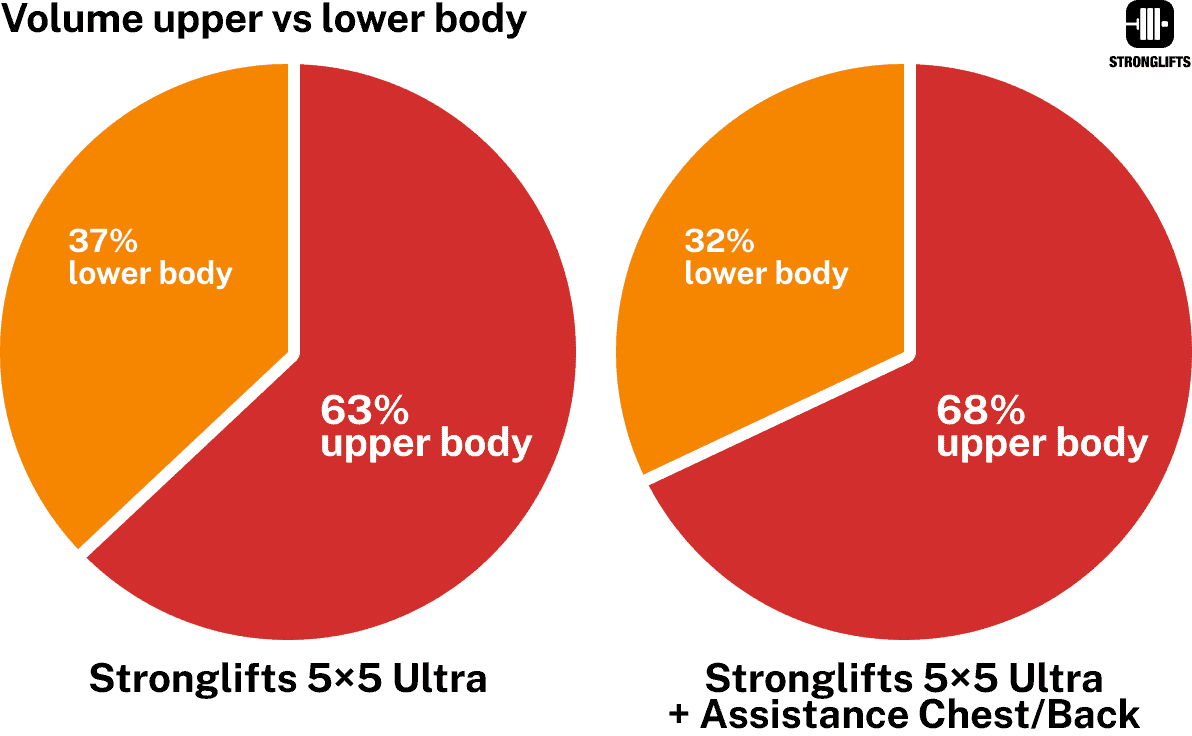
The main lifts are enough to build strength and muscle with Stronglifts 5×5 Ultra. But if you have time and energy to do more, you can add one of the options for Assistance Work in the Stronglifts app. Go to program, Stronglifts 5×5 Ultra, pick your template, Assistance Work. The “total body” option adds the most volume (for chest, shoulders, back, arms, abs, and legs).
How Stronglifts 5×5 Ultra came to be
As always, the idea for Stronglifts 5×5 Ultra came from Stronglifters.
A common issue on Stronglifts 5×5 is that workouts become longer over time. The weights you lift increase as you get stronger. This is great – it means the program works. However a side-effect is the need for more warmup sets and longer rest periods. While you could finish the workout in 30min at first, like I’m doing here, this becomes impossible once you’re a lot stronger.
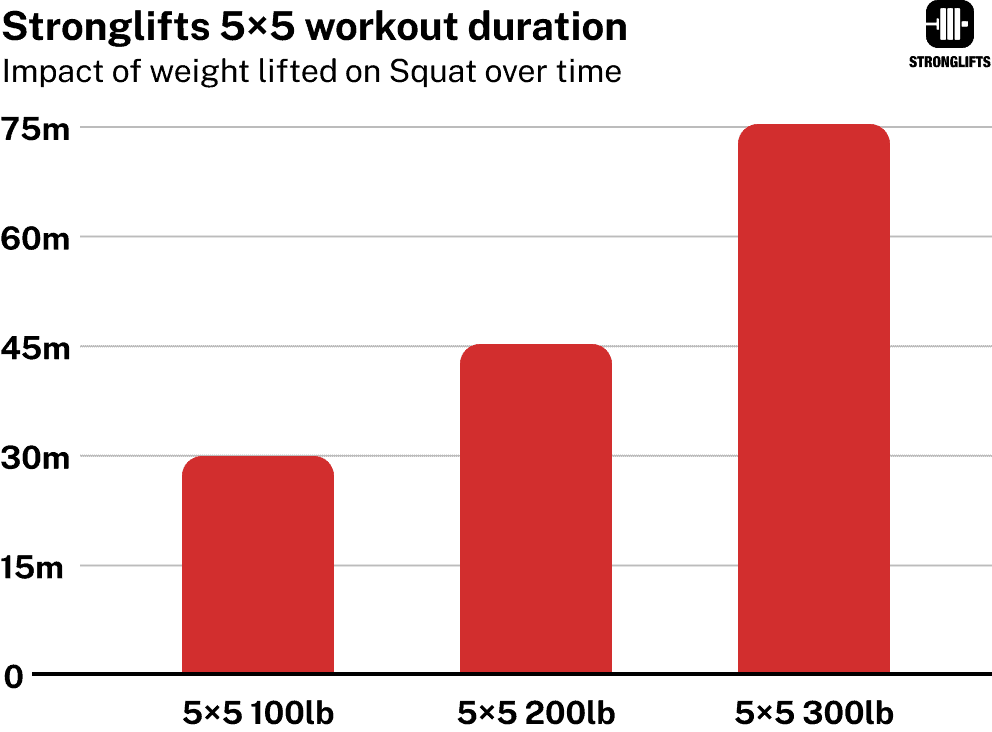
There are several simple solutions to prevent your Stronglifts 5×5 workouts from taking forever once you’re lifting heavier weights…
- Skip the cardio and stretches pre-workout. Hard cardio can tire you out for the weights (13). Stretching doesn’t decrease soreness or prevent injury (14, 15, 16, 9). Do this stuff on your rest days instead.
- Don’t rest between warmup sets. They’re light so there’s no need to rest a lot. Add weight on the bar and then do your next set. Only rest before doing your last and heaviest warmup set.
- Switch to top/back-off sets. You’ll get away with only two minutes rest on your back-off sets without failing reps. Only your heaviest top set needs longer rest periods of three to five minutes.
- Use the built-in timer of the Stronglifts app. Many people play with their phones in the gym and lose track of time. The timer will notify you when you have to do your next set so you don’t waste time.
Some Stronglifters were lifting for two hours or more because they were resting too much and still doing straight sets. The above tips reduced their workout times to 75-90min. But for some this isn’t enough. They need to be done within 60min, like they did during the first weeks of the program.
A common question was therefore: why not split the Stronglifts 5×5 workout into a morning and afternoon session? Each workout would then not take more than an hour. Here are examples of emails I’ve received…
Hi Mehdi,
Thank you for the Stronglifts website, app and e-mail tips. I increased my 5×5 Squat from 20 to 100kg in exactly 12 weeks, despite being 46 and having shoulder surgery 6 months ago. Stronglifts is the straight line path to strength gains!
After week 12, my biggest problem is total workout time which approaches 90 mins. What do you think about splitting the workout through the workout day. i.e Squats in the morning, the other two exercises in the evening?
George, 46, Greece
Hi Mehdi,
I’ve been doing the Stronglifts 5×5 for three months now, and with the warmups the time of the workout takes over an hour. I have time during my lunch where I could knock squats out. Is it ok to split a workout in half during a day?
Tomek
To be clear, these Stronglifters were thinking of splitting the Stronglifts 5×5 workout into a morning and afternoon session like this…
| Stronglifts 5×5: splitting the workouts to 2×/day | ||
|---|---|---|
| Monday, AM | Wednesday, AM | Friday, AM |
| Squat 5×5 | Squat 5×5 | Squat 5×5 |
| Monday, PM | Wednesday, PM | Friday, PM |
| Bench Press 5×5 | Overhead Press 5×5 | Bench Press 5×5 |
| Barbell Rows 5×5 | Deadlift 1×5 | Barbell Rows 5×5 |
Now I have experience training 2x/day. I’ve done Bench in the morning, Squat in the afternoon. I wanted to see if my Bench would progress better without fatigue from the Squat. I learned two things. One, it didn’t help my Bench get stronger. Two, the total workout time was much longer because I had to do more of everything – warming up, setting the equipment, putting it away, showering, etc. So I eventually stopped training 2x/day.
Splitting the Stronglifts 5×5 workout would shorten the sessions. But the total workout time would be greater. More importantly, doing Squats in the morning but the rest in the afternoon splits the workout into a lower and upper body session (with deadlifts being the only exception). Consider…
| Stronglifts 5×5: splitting the workouts to 2×/day | ||
|---|---|---|
| Monday, AM | Wednesday, AM | Friday, AM |
| Lower Body (SQ) | Lower Body (SQ) | Lower Body (SQ) |
| Monday, PM | Wednesday, PM | Friday, PM |
| Upper body (BP) | Upper body (OHP) | Upper body (BP) |
| Upper body (ROW) | Lower Body (DL) | Upper body (ROW) |
So why not turn Stronglifts 5×5 into an upper/lower body split instead? Just do one day lower body, one day upper body. The volume will be almost the same and thus so will your results. Your workouts will be shorter because you only do two compound lifts per session. You’ll save time because it’s only four workouts per week and not six, unlike when training twice a day.
Full body and upper/lower are my two favorite workout splits. I’ve done them a lot over the past twenty years. They both have their pros and cons as we’ll discuss in the FAQs below. One benefit of a four day upper/lower workout split is that it’s easier to do more volume compared to a three day full body split. And so I decided to call this program Stronglifts 5×5 Ultra.
Stronglifts 5×5 Ultra vs Stronglifts 5×5
Here’s the difference between both training programs…
- Stronglifts 5×5 is a full body split for new or returning lifters who want to build strength and muscle but need to learn how to lift first. The Squat is practiced a lot so you get the form down as quickly as possible.
- Stronglifts 5×5 Ultra is an upper/lower split for more experienced lifters who have done Stronglifts 5×5 but are past the easy beginner gains. The workouts are shorter which allows for more volume.
Let’s start by comparing the volume of both programs. Your training volume is how many weekly hard sets you do per muscle or movement. Doing more volume typically results in more strength and muscle gains (4, 5, 6).
| Weekly sets | Stronglifts 5×5 | Stronglifts 5×5 Ultra |
|---|---|---|
| Chest | 7.5 | 10 (+33%) |
| Back | 9 | 11 (+22%) |
| Shoulders | 15 | 15 |
| Triceps | 15 | 15 |
| Biceps | 7.5 | 5 (-33%) |
| Legs | 16.5 | 12 (-27%) |
Stronglifts 5×5 Ultra has a little more volume for chest and back compared to Stronglifts 5×5, but less volume for legs and biceps. You end up with slightly more training volume for your upper than lower body. Compare…
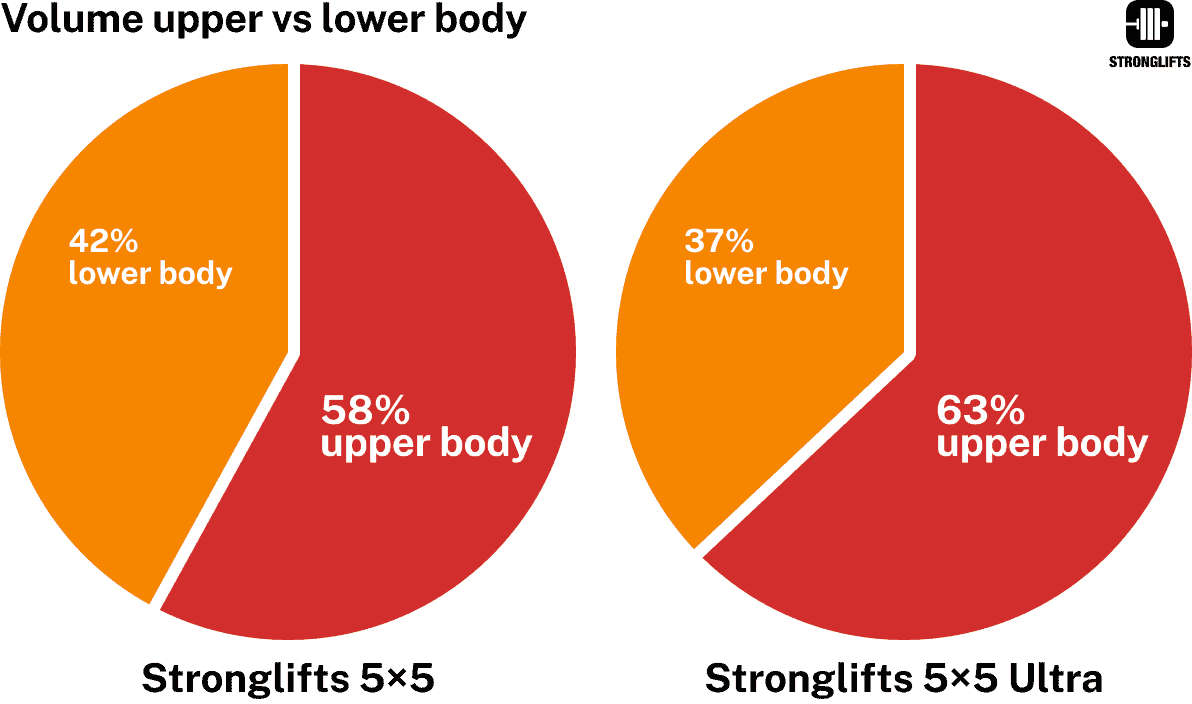
Here’s the math. We’re taking the weekly set average for Stronglifts 5×5 because you alternate weeks of workouts A/B/A with B/A/B.
| Weekly Sets | Upper body BP, OHP, Row | Lower body SQ, DL |
|---|---|---|
| Stronglifts 5×5 | 22.5 | 16.5 |
| Stronglifts 5×5 Ultra | 20 | 12 |
The difference in volume is because you’re only doing two exercises in each Stronglifts 5×5 Ultra workout. That’s eight weekly exercises over four workouts vs nine exercises if you do Stronglifts 5×5 3x/week. You’re also not doing 5×5 on Squats and Deadlifts every time with Stronglifts 5×5 Ultra.
| Exercises | Stronglifts 5×5 | Stronglifts 5×5 Ultra |
|---|---|---|
| Exercises/workout | 3 | 2 |
| Workouts/week | 3 | 4 |
| Exercises/week | 9 | 8 |
This is one of the benefits of upper/lower splits like Stronglifts 5×5 Ultra. You only do two exercises per workout. And so you can easily add assistance work to increase volume without your workouts taking forever.
Adding assistance work to the upper-body workouts of Stronglifts 5×5 Ultra is easy. Exercises like Bench Press use less and smaller muscles than Squats. The weight you Bench is usually about 1.5x lower than what you Squat (17). This results in less warmup sets. The rest periods are also shorter because upper-body lifts are less demanding. That’s why the upper-body workouts are shorter than the lower body ones in which you Squat and Deadlift.
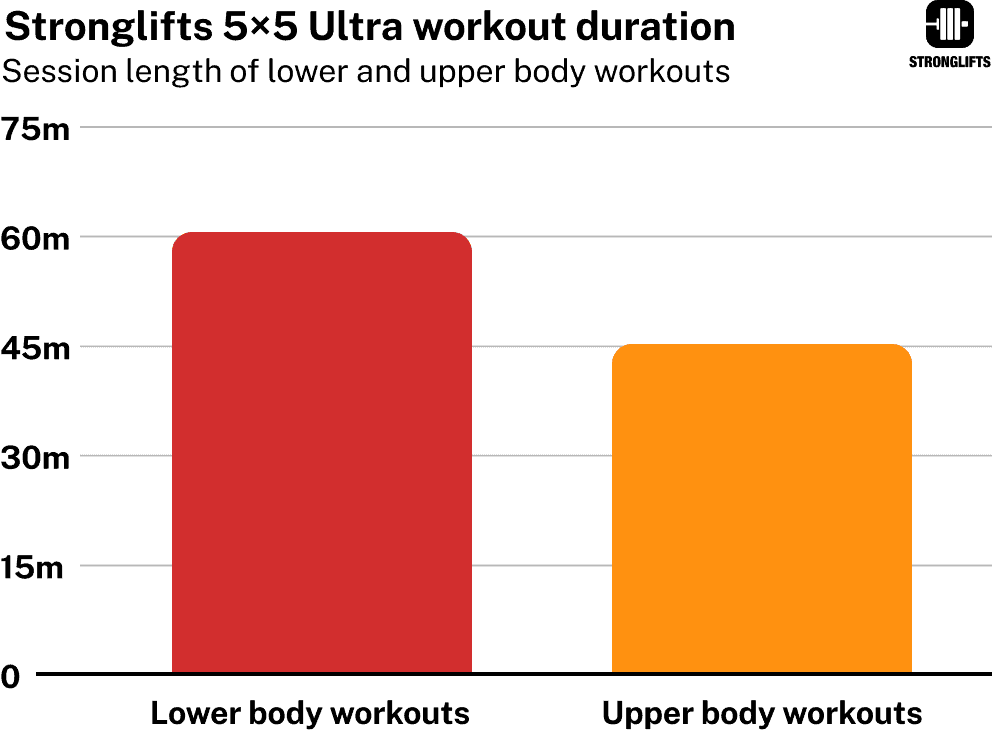
You can therefore easily add assistance work for your chest, back and arms to the upper-body workouts while still being finished within an hour. Say you add three sets of Dips, Curls, Pullups and Skullcrushers. Like this…
| Stronglifts 5×5 Ultra + Assistance Chest/Back/Arms | |||
|---|---|---|---|
| Workout A | Workout B | Workout C | Workout D |
| Squat 5×5 | Bench Press 5×5 | Deadlift 5×5 | Overhead Press 5×5 |
| Deadlift 1×5 | Barbell Row 5×5 | Squat 1×5 | Bench Press 5×5 |
| Dips 3×8 | Pullups 3×8 |
||
| Barbell Curls 3×8 | Skullcrushers 3×8 |
||
Two extra exercises on your upper-body days will only add 15min of gym time. You can still finish within an hour if you’re strict with your rest times.
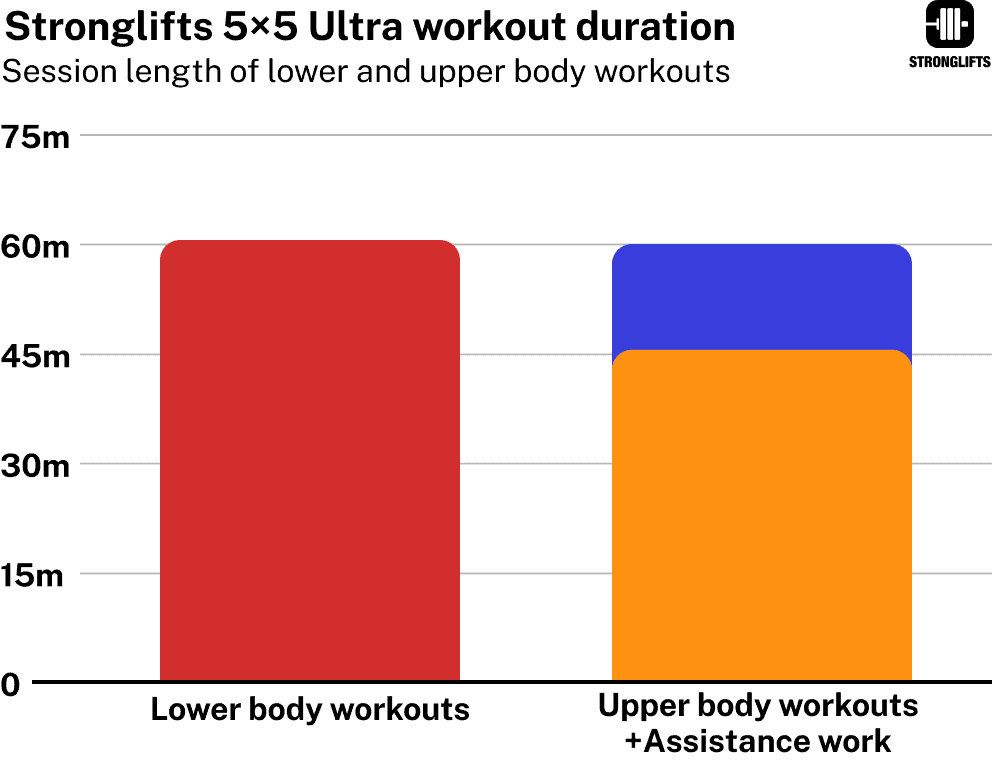
Here’s your weekly training volume on Stronglifts 5×5 Ultra for your major muscle groups if you add Assistance Work to your upper-body workouts…
| Weekly sets | Stronglifts 5×5 | Stronglifts 5×5 Ultra + Assistance Work |
|---|---|---|
| Chest | 7.5 | 13 (+73%) |
| Back | 9 | 14 (+56%) |
| Shoulders | 15 | 18 (+20%) |
| Triceps | 15 | 21 (+40%) |
| Biceps | 7.5 | 11 (+47%) |
| Legs | 16.5 | 12 (-27%) |
The training volume for your upper body is higher on Stronglifts 5×5 Ultra because you’re doing more exercises. But your average workout duration is the same or shorter than on Stronglifts 5×5. One, you only do two compound exercises each workout. Two, the upper-body workouts are shorter because of the nature of the exercises. The only difference is that you have to do four workouts per week with Stronglifts 5×5 Ultra to get more volume in.
Another difference between Stronglifts 5×5 and Stronglifts 5×5 Ultra is the frequency of the lifts – how often you do each movement. Compare…
| Frequency | Stronglifts 5×5 | Stronglifts 5×5 Ultra |
|---|---|---|
| Squat | 3×/week | 2×/week |
| Bench | 1.5×/week | 2×/week |
| Deadlift | 1.5×/week | 2×/week |
| OHPress | 1.5×/week | 1×/week |
| Barbell Row | 1.5×/week | 1×/week |
Stronglifts 5×5 Ultra has fewer Squats. You only do them twice a week. But it has more Bench and Deadlifts: you do these 2x/week. On Stronglifts 5×5 you do these two lifts once every other week but Squat three times every week. This works better for new or returning lifters for a couple of reasons…
- Squats are more technical than Bench and Deadlifts. The range of motion is longer. You have to go all the way down with the weight and then come back up. Many things can go wrong. The weight rests on your back where you can’t see it, and presses you down. If you can’t lift it, you get stuck under. Squats are intimidating and scary. Practicing it a lot at first gets you comfortable faster so you can go heavier sooner.
- Squats and Deadlifts work similar muscles. Less experienced lifters can easily increase their Deadlift by Squatting three times a week (18). Deadlifts are less technical. The range of motion is shorter, and the lift starts at the bottom. That’s why it’s common for powerlifters to train the Deadlift less often than the Squat (19, 20)
- The Bench Press doesn’t need a lot of volume to progress at first. Most people’s upper body is less trained when they start lifting because they use their legs more in daily activities (21). Their chest and bench can initially progress without doing a ton of sets (22, 23, 24).
Things change as you get stronger and lift heavier weights. Squatting 3x/week with 5lb more each time becomes too hard. Bench and Deadlift start needing more volume and frequency to progress (23, 25). That’s why Stronglifts 5×5 Intermediate has 2x/week Squats, 3x/week Bench and 2x/week Deadlifts. The exercise frequency on Stronglifts 5×5 Ultra is similar…
| Frequency | SL5×5 | SL5×5 Ultra | SL5×5 Intermediate |
|---|---|---|---|
| Squat | 3×/week | 2×/week | 2×/week |
| Bench | 1.5×/week | 2×/week | 3×/week |
| Deadlift | 1.5×/week | 2×/week | 2×/week |
Stronglifts 5×5 Ultra isn’t a beginner program for new or returning lifters. They can progress faster on Stronglifts 5×5 where they practice Squats more often. They can progress fine training only 3x/week. Once the weights are heavier, the workouts are longer, and Squatting 3x/week becomes too hard, then it makes sense to switch to Stronglifts 5×5 Ultra.
Stronglifts 5×5 Ultra FAQs
What are the benefits of upper/lower splits?
Upper/lower splits like Stronglifts 5×5 Ultra take less time per workout. Unlike full body splits like Stronglifts 5×5 you only do two big compound exercises in each workout. You also don’t train your legs every session. This results in shorter workouts that take less time to complete on average.
Some people find that their training quality improves with upper/lower splits. For example, the Bench is done first and fresh in the upper-body workout B of Stronglifts 5×5 Ultra. There’s no fatigue from Squatting before. This can help train the Bench Press harder and with more focus, resulting in better progress than when doing full body workouts like Stronglifts 5×5. With longer workouts, training quality often declines near the end of the session.
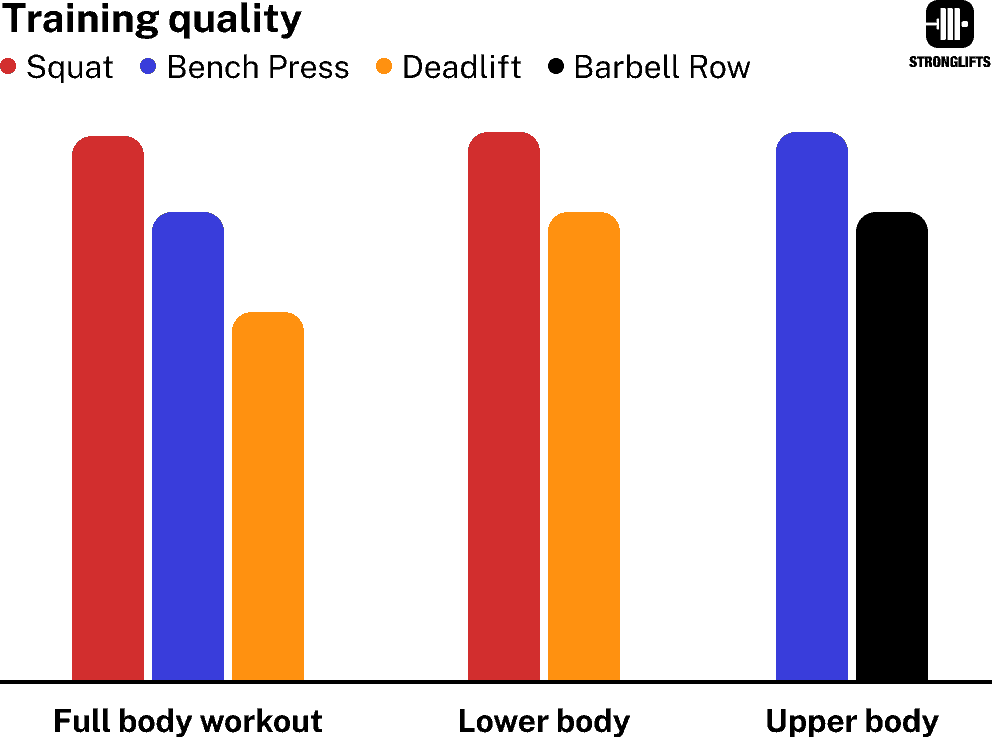
Other benefits of upper/lower body splits include…
- You can train the Squat, Bench and Deadlift twice every week. Strength = skills × muscle (26, 27). Practicing the lifts more helps improve your technique, which can increase strength (28). In fact, it’s typical for powerlifters to Squat and Bench Press 2x/week each (20).
- You can do more volume to stimulate muscle growth aka hypertrophy. First, because you’re doing four workouts per week. Two, because you only do two compound lifts per workout. You can easily add assistance work to build more muscle while keeping your workout under 60min.
- You alternate harder and easier workouts. The lower body sessions are harder because Squats and Deadlits work bigger and more muscles. The weight lifted is higher, and so these sessions demand more out of you. The upper-body workouts are lighter and easier.
If you’re past the easy beginner gains, you’re lifting heavier weights and your workouts have become longer, an upper/lower split like Stronglifts 5×5 Ultra can work better than a full body split like Stronglifts 5×5.
What are the drawbacks of upper/lower splits?
Upper/lower splits require four workouts per week to reap the benefits of more volume for hypertrophy and higher frequency for strength. If you only do three or two workouts a week, your volume and frequency will be lower. You’re better of doing a full body workout like Stronglifts 5×5 in this case.
That’s why 2-3 full body workouts per week is recommended for beginners (9). Most people don’t have time to train (29, 30, 31). You don’t need much volume to build strength and muscle during the first months of training. Full body workouts take less days per week. This is easier to stick to.
For example, a study by Pederson et al compared 2x/week full body split to 4x/week upper/lower split in untrained women (32). Four out of 24 dropped out of the upper/lower split group due to lack of time. None of the 26 women training full body 2x/week dropped out. This means that 17% dropped out of the upper/lower split because it took more days per week.
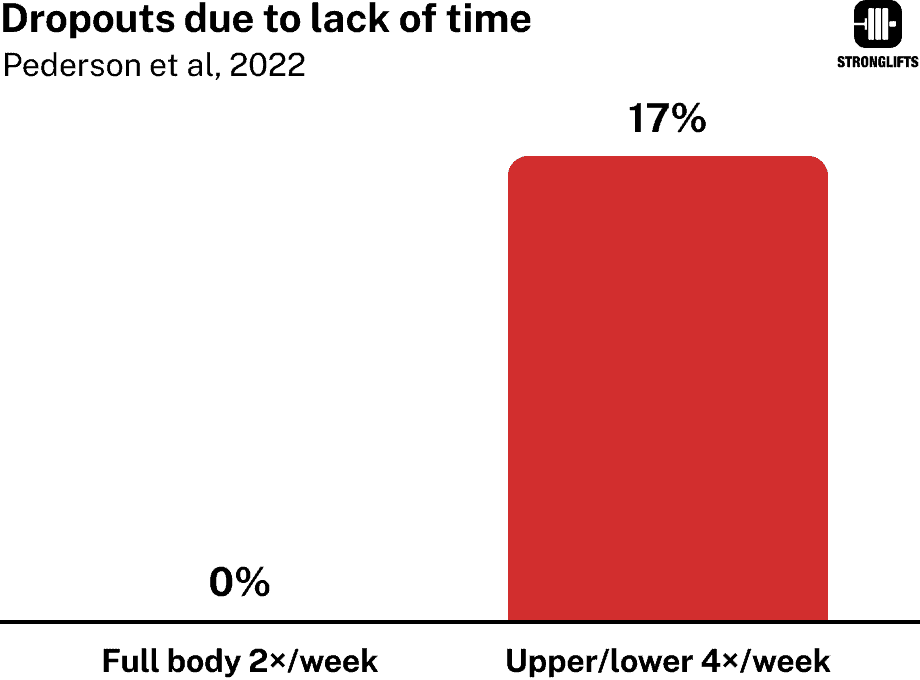
Another drawback of upper/body splits is that some people find the workouts harder to complete than full body workouts. Here’s the difference…
- With full body splits like Stronglifts 5×5, your workout alternates legs (Squat) with upper body (OHPress) before doing legs again (Deadlifts). Your legs can rest while you train your upper body and vice versa.
- With upper/lower splits like Stronglifts 5×5 Ultra, you work the same muscles with several exercises in a row. For example, in workout A you Deadlift right after Squats. This causes a lot of fatigue. That’s why you only do 1×5 on the second lower body exercise (more on this below).
If you’re a new or returning lifter, and you don’t have much strength, muscle or fitness yet, you’re better off doing a full body split like Stronglifts 5×5. Wait to do an upper/lower split until you’re more experienced.
Are upper/lower splits better for recovery?
Not necessarily.
One of the main factors that determine your recovery is how much volume you do. Upper/lower splits can be easier to recover from if they spread your usual training volume from three to four workouts per week. But they can also be harder to recover from if they increase the total amount of volume you do. Just the workout split doesn’t tell much on its own.
Many people say that upper/lower splits are easier to recover from than full body splits. If you train lower body Monday and Thursday, your legs have 72 hours to recover. With a full body workout like Stronglifts 5×5 where you train legs Monday, Wednesday and Friday, they only get 48h of recovery.
| Recovery | Stronglifts 5×5 | Stronglifts 5×5 Ultra |
|---|---|---|
| Split | Full body | Upper/lower |
| Legs/week | 3× | 2× |
| Recovery | 48h | 72h |
| Sets/week legs | 16.5 | 12 |
But studies comparing back-to-back workouts to resting for 48 hours find no difference (1, 2, 3). Despite the shorter recovery time, the lifters training back-to-back gain as much strength and muscle as the ones resting 48h between workouts. Other studies compared full body and upper-lower splits with equal volume (32, 33, 34). Here too the strength and muscle gains are similar.
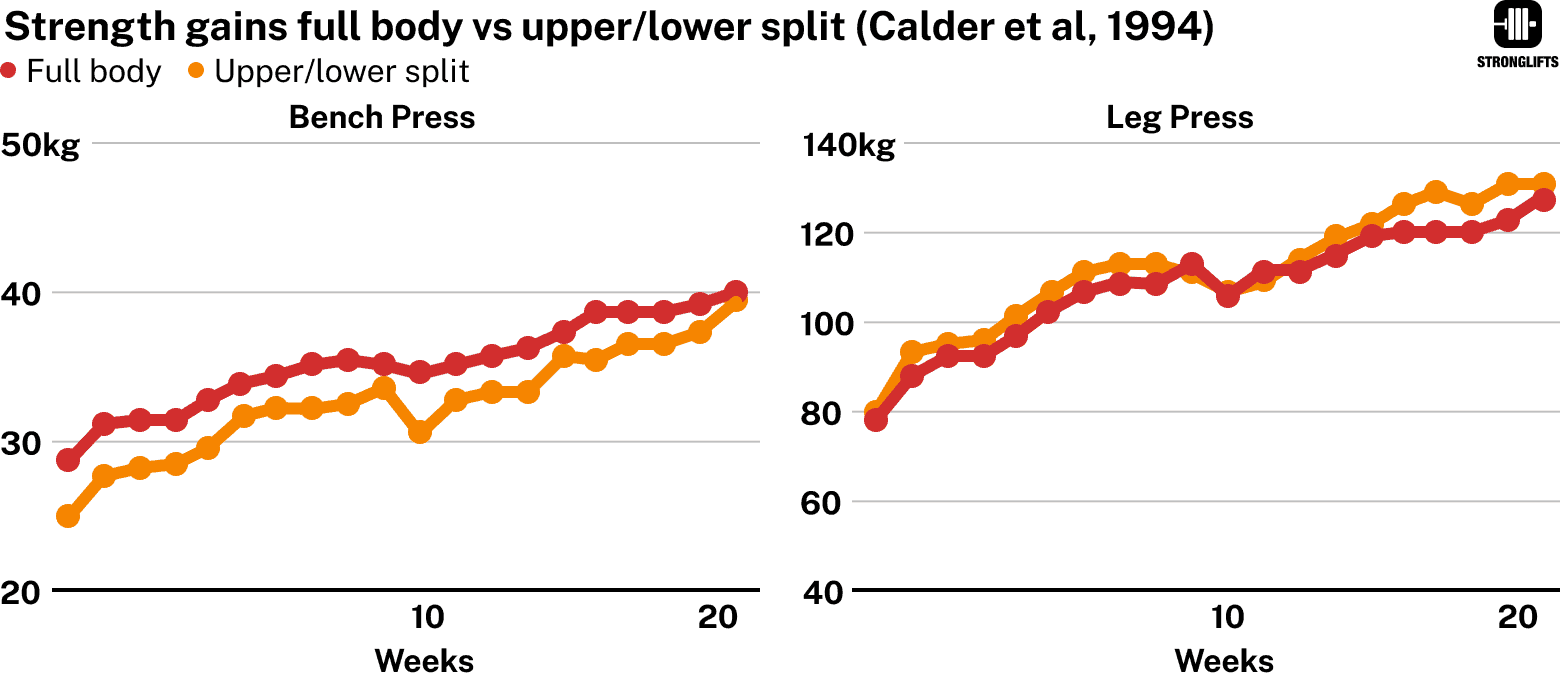
I’ve done four day upper/lower splits, and four day full body splits. In both cases I train Mon, Tue, Thu, Fri. With full body splits, I do Squat Mon/Thu and Deadlift Tue/Fri. Bench is 4x/week right after SQ or DL. Twice a week I do an extra Squat and Deadlift movement. That means 3x/week SQ, 3x/week DL, 4x/week Bench plus some OHP and Rows (yes, lots of volume because I’ve been training for many years, and this is what I need to progress).
The four day full body split is definitely harder than the four day upper/lower-split. But that’s because the training volume is higher. When I do a four day upper/lower split, I “only” do four exercises per week for legs, not six. When I tried say Squat, RDL, Lunges on the same lower body day, it was too much. Four day full body splits allows me to do more volume because the legs can rest while you train upper body on the same day and vice versa. But training legs 4x/week and doing more volume is definitely more tiring.
Say you’ve been doing a full body split like Stronglifts 5×5 3x/week. You switch to a 4x/week upper/lower split like Stronglifts 5×5 Ultra while doing the same amount of volume. You should expect the workouts to be easier. The same volume is spread over more sessions which makes your workouts easier to recover from. However if you add a lot of assistance work to increase volume, you may find the workouts more tiring than before.
Who is Stronglifts 5×5 Ultra for?
Stronglifts 5×5 Ultra is for lifters who are past the easy beginner gains. You’ve done Stronglifts 5×5 for a while. You know how to Squat, Bench and Deadlift with good form. You can Squat and Deadlift more weight than you Bench.
But your workouts have become too long because you’re lifting much heavier weight than when you started. You need more warmup sets and longer rest periods. You’ve already switched to top/back-off sets and are strict with your rest periods. But the workouts are still taking too long. Switching to Stronglifts 5×5 Ultra will shorten your workout time to 60min or less per session.
You can also switch to Stronglifts 5×5 Ultra once Squatting 3x/week with 5lb more each time has become too hard. You’ll now only Squat in the lower body sessions or 2x/week. One session has 5×5 Squats, the other 1×5 Squats. This is easier to manage once you’re lifting heavier weights.
Who is Stronglifts 5×5 Ultra not for?
Stronglifts 5×5 Ultra is not for new or returning lifters.
Beginners can progress faster with a full body workout split like Stronglifts 5×5. You get more practice for the most intimidating, scary and technical of all lifts – the Squat. You only need to go to the gym 3x/week. This is enough to progress because beginners don’t need much volume. Stronglifts 5×5 Ultra has more Bench and Deadlift practice. But both lifts are less technical than the Squat. They can progress fine with less practice when you’re starting out.
Should I start the week with upper or lower body?
Lower body.
Stronglifts 5×5 Ultra is an upper/lower body split. And so you might be thinking about starting the week with the upper-body workout as the name suggests. However it’s better to start the week with the lower body day.
| Order | Monday | Tuesday | Thursday | Friday |
|---|---|---|---|---|
| 1 | Lower | Upper | Lower | Upper |
| 2 | Upper | Lower | Upper | Lower |
Here’s why starting the week with the lower body workout is better:
- Monday is National Bench day. Many gym goers train Bench Press the first day of the week because they care mostly about their chest. The bench will be busy. If you train your lower body instead, you won’t need to wait for the bench to be free. This saves you time.
- Lower body workouts are harder. Squats and Deadlifts work larger and more muscles. The exercises are more demanding. And so it makes sense to do them right after the weekend, where you had two days of rest. This way you also end your week with an easier upper-body workout on Friday when your weekend is about to start.
- You need your upper-back for Squats and Deadlifts. If you start your week with the upper-body workout B, and tire your upper-back with Barbell Rows, you’ll struggle to keep the bar in position for Squats. You don’t get this problem if you train your lower body first.
Some people say Squats and Deadlift create general fatigue that makes it difficult to train the upper body hard the next day. This is certainly possible if you do excessive amounts of volume, but is unlikely on Stronglifts 5×5 Ultra. Plus a study by Belcher et al found that there wasn’t much difference in recovery time between the Squat, Bench and Deadlift (35).
Can I rest between the lower and upper body days?
You could train Mon, Wed, Fri, Sat instead of Mon, Tue, Thu, Fri. You then only train your upper and lower body back-to-back once a week instead of twice. This gives you one rest day after three out of the four workouts.

Some people recommend this schedule for upper/lower splits because your legs get more days to recover after your lower body workouts. This is true for workout A. But it’s not true for workout C. Compare…
| Schedules | Mo/We/Fr/Sa | Mo/Tu/Th/Fr |
|---|---|---|
| Back-to-back | 1×/week | 2×/week |
| Leg Recovery after A | 96h | 72h |
| Leg Recovery after C | 72h | 96h |
The Mo/We/Fr/Sa schedule gives your legs 96h to recover after lower body workout A. But you only get 72h of recovery after lower body workout C. With the Mo/Tu/Th/Fr schedule, your legs “only” get 72h to recover after workout A. But they get 96h of recovery after workout C. Your legs get an equal amount of recovery time in both cases. It’s simply distributed differently.
The only difference is that with the Mo/We/Fr/Sa schedule you only train back-to-back once a week. But studies comparing back-to-back workouts to resting 48h found no difference (1, 2, 3). The lifters that train back-to-back gain as much strength and muscle as the ones resting 48h between workouts. It’s possible that the lifters who need a full day to recover after doing lower body workouts are simply doing excessive amounts of volume.
The drawback of the Mo/We/Fr/Sa schedule is that you have to train on the weekend. Many people prefer to keep them free for family and friends. Many people like to have two full days off before starting a new training week. Lots of people are more consistent with their training if they stack it on top of their existing work routine, which is typically on weekdays.
Clearly, I prefer the Mo/Tu/Th/Fr schedule for upper/lower splits like Stronglifts 5×5 Ultra. But if you prefer to rest one day between the lower and upper body workouts, that’s fine too. It will make little to no difference in results. It mostly comes down to your personal preference. The Stronglifts app supports both schedules so you can run Stronglifts 5×5 Ultra however you like.
Can I do upper lower 2×/week?
You can if you only have two days to train, and they must be back-to-back.
Say you’re a weekend warrior who can only workout on Saturday and Sunday. Training your lower body one day and upper body the next is easier than two full body workouts back-to-back. However you’ll train each movement only once a week instead of twice like with full body workouts. For improving your technique on free weight exercises, practicing twice would be better.
Can I do upper lower 3×/week?
You could but a full body split like Stronglifts 5×5 3x/week would be better. The main benefits of upper/lower splits is that you can do more volume and frequency. You lose these benefits if you only do three workouts per week.
Compare the volume first. We take the weekly average for Stronglifts 5×5 Ultra 3x/week because you’ll alternate weeks of lower/upper/lower with upper/lower/upper. Same for Stronglifts 5×5 (A/B/A, B/A/B, etc).
| Weekly sets | SL5×5 Ultra 4×/week | SL5×5 Ultra 3×/week | SL5×5 3×/week |
|---|---|---|---|
| Chest | 10 | 7.5 | 7.5 |
| Back | 11 | 10 | 9 |
| Shoulders | 15 | 8.5 | 15 |
| Triceps | 15 | 10 | 15 |
| Biceps | 5 | 5 | 7.5 |
| Legs | 12 | 9 | 16.5 |
| Total Upper | 20 | 15 | 22.5 |
| Total Lower | 12 | 9 | 16.5 |
The volume for your upper body and legs is higher if you do Stronglifts 5×5 than Stronglifts 5×5 Ultra 3x/week. Doing more volume typically results in more strength and muscle gains (4, 5, 6). You’d have to add assistance work to Stronglifts 5×5 Ultra to make up for the lower of volume.
Compare also the frequency – how often you do each exercise. Doing an exercise more frequently typically results in more strength gains because you can practice the technique more which improves your skills.
| Frequency | SL5×5 Ultra 4×/week | SL5×5 Ultra 3×/week | SL5×5 3×/week |
|---|---|---|---|
| Squat | 2×/week | 1.5×/week | 3×/week |
| Bench | 2×/week | 1.5×/week | 1.5×/week |
| Deadlift | 2×/week | 1.5×/week | 1.5×/week |
| OHP | 1×/week | 0.5×/week | 1.5×/week |
| Row | 1×/week | 0.5×/week | 1.5×/week |
The frequency is the same for the Bench Press and Deadlift when you do Stronglifts 5×5 Ultra 3x/week. But it’s higher for Squats, Overhead Press and Barbell Rows if you do Stronglifts 5×5 3x/week.
Stronglifts 5×5 Ultra 3x/week makes sense if you want to train your lower body 1x/week but upper body 2x/week. But I would recommend Stronglifts 5×5 Plus in this case. It’s an upper-body hypertrophy program that mixes full and upper-body workouts. It’s higher in volume but only takes three workouts a week.
Can I do upper lower 5×/week?
Yes, you could add a third upper-body workout to the program. You then train your lower body twice, and your upper body three times a week.
Example schedule if you do 5 workouts per week…
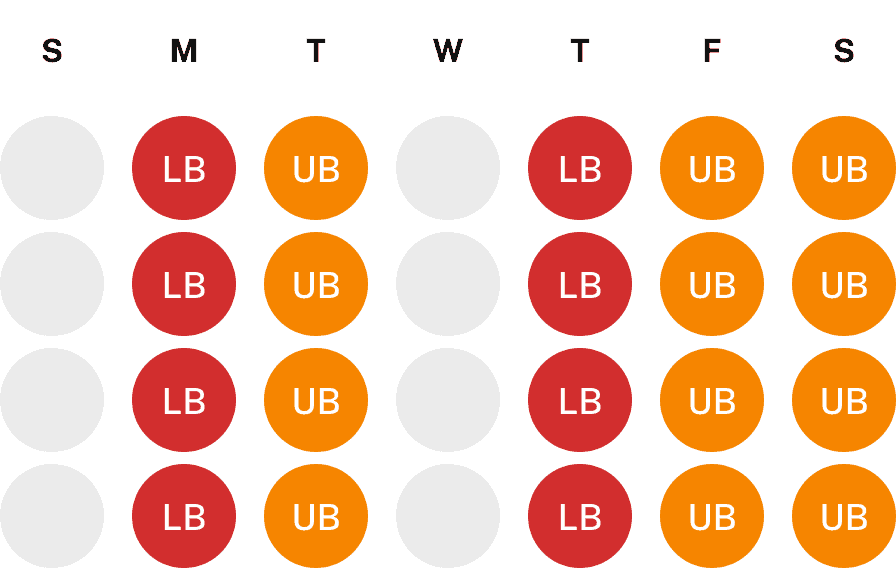
You could also train five days in row instead so your weekends are off.
For more info, check the Stronglifts 5×5 Ultra Max program. It’s a 5x/week upper/lower body split with three upper-body workouts per week.
How to progress?
Add weight on the bar over time.
Muscular tension is the main driver of muscle growth (7, 8, 9). To build muscle as a drug-free lifter, you need to progressively increase the tension on your muscles. You do this by adding weight on the bar over time. This tells your body to build muscle so it can handle the heavier weights.
If you’re not lifting more weight than you did six months ago, you won’t have more muscle – no matter how pumped or sore you got. You need to apply progressive overload in order to build muscle. This is a fundamental principle of strength and muscle building (8). Fundamental means that if you don’t apply progressive overload, your program training can’t work. Quote from the American College of Sports Medicine (9)…
As the trained muscles strengthen and enlarge (hypertrophy), the resistance must be progressively increased if additional gains are to be accrued.
The American College of Sports Medicine
Many people struggle to build muscle because they’re not adding weight to the bar. For example a study by Barbosa-Netto asked 160 lifters how much weight they usually Bench for 10 reps (36). They then made them Bench that weight to failure. The average lifter did 16 reps. Almost a quarter did 20 reps or more. Three quarters said that their main goal was hypertrophy – building muscle. Yet the weren’t training heavy enough to cause muscle growth.
If you complete all sets with good form, add weight. Add 5lb or less on the bar. You don’t have to add weight every workout, but you can’t lift the same weight for six months. You must add weight to stimulate growth. The Stronglifts app automatically increases the weight when you complete your sets. You can decide how much weight it adds and how often it does so.
Read also: how to progress on Stronglifts 5×5
How long should I rest between sets?
Rest as much as you need to complete your next set. For most sets this will be about three minutes. Easy sets will only need 1-2min rest. Your hardest sets may need 5min rest periods so you don’t fail reps.
Contrary to popular belief, shorter rest periods don’t build more muscle (37). They give your ATP-PC energy system less time to recover. Research shows that your energy stores are only 75% recovered after 1min rest, but 91% after 3min and 95% after 5min (38). Longer rest periods help you do more reps per set and lift heavier because your energy stores had more time to recover.
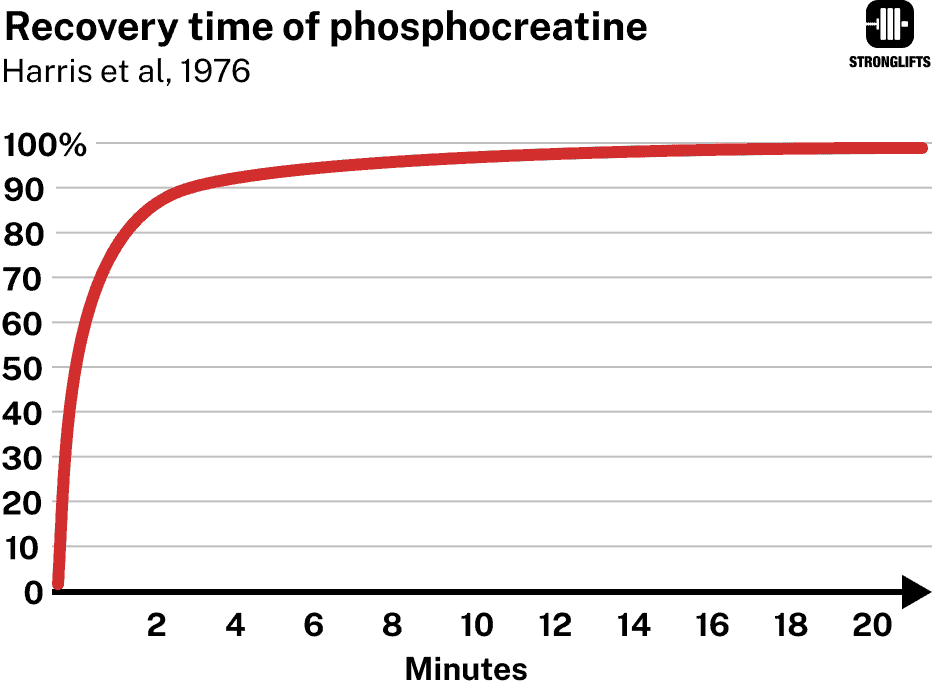
For example, a study by Hernandez et al had 15 men Bench Press four sets with 85% of their max (39). The group that rested 2min did 16 reps in total. The 5min group did 19 reps. The 8min group did 24 reps. They did more reps because their energy stores were more recovered.
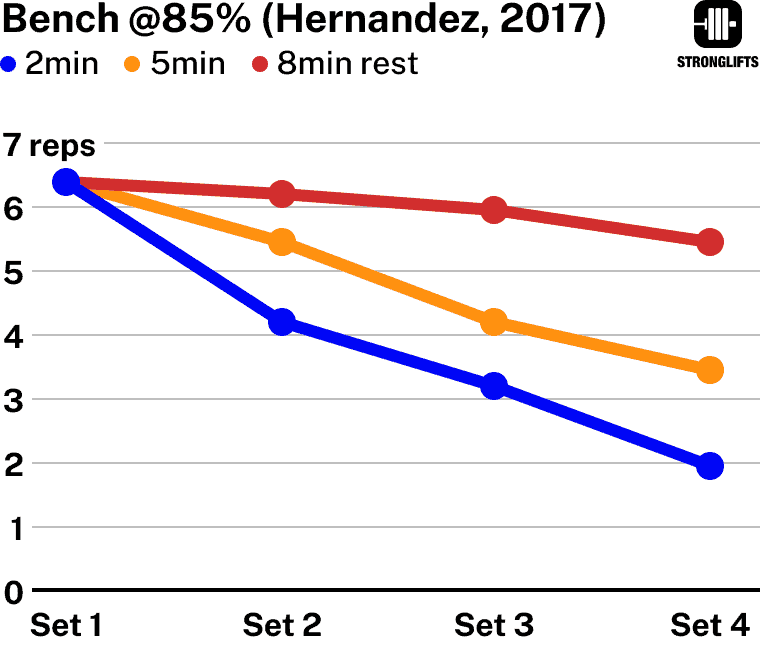
Longer rest periods help you do more volume, which typically results in more strength and muscle gains (4, 5, 6). A study by Longo et al compared one and three minutes rest (37). The 1min group had to do more sets to get the same result as the 3min group. Resting longer between sets actually saves time. You don’t need to do as many sets to get the same results.
You don’t need to rest 5min if you can complete your set with only one minute rest because it’s easy. But for difficult sets, you’ll need 3 to 5min rest to avoid failed reps. The Stronglifts app has a built-in rest timer that notifies when it’s time for your next set. It will tell you to rest more if you failed your last set so you don’t fail again on your next set. This helps you to progress more.
Are upper lower splits good for beginners?
No. Beginners can progress faster with full body workout like Stronglifts 5×5. You can practice the Squat more often. You only need to workout 3x/week. Beginners don’t need much volume to progress. Do Stronglifts 5×5 for 12 weeks or so to learn the basics. After that switch to Stronglifts 5×5 Ultra.
Why only 1×5 Deadlifts after 5×5 Squats?
5×5 Deadlifts right after 5×5 Squats is hard.
Both exercises work similar muscles. Squats create fatigue. Right after that you have to Deadlift a heavier weight. Five sets of that adds more fatigue for muscles that are already tired. It’s easy for your form to get sloppy when tired. Lifting weights has a low risk of injury, but fatigue is a risk factor (40, 41). And so I kept the Deadlifts to 1×5 after Squats.
Note that you’ll do 5×5 Deadlifts as first exercise in workout C (after which you’ll do 1×5 Squats for the same reasons). If you can handle more than 1×5 Deadlifts in workout A after 5×5 Squats, feel free to do more. I recommend top/back-off sets to reduce fatigue and save time. You don’t have to add four back-off sets but could only add one or two.
Alternatively, do one of the variations of Stronglifts 5×5 Ultra in the Stronglifts app. The “Build” template puts Romanian Deadlift after Squats in workout A. The weight on this lift is lighter, and so it’s easier to do more than 1×5. Just open the Stronglifts app, go to program, tap Stronglifts 5×5 ultra, and select the Build template. You can add sets as needed.
Why abs in the lower body workout?
The Assistance Work for Stronglifts 5×5 Ultra puts exercises for your abs in the lower body workout. But your abs are located in your upper-body. So why not put the ab exercises in the upper body workouts?
First, many exercises aren’t pure lower or upper body. Deadlifts for example work your upper-body quite a bit – your upper-back, lats, traps, and forearms all work when you pull heavy. Even Squats work your back and arms as they hold the bar in position while your legs lift the weights. The line between upper and lower body isn’t clear-cut when doing compound lifts.
Ab exercises go on your lower body days for purely practical reasons. Most people find two compound exercises for the legs enough on the lower body days. They don’t want more volume. The only add assistance work for the upper-body. Putting ab exercises on the lower body days creates room for more upper-body exercises on the upper-body days.
There’s no workout split police that will to come to your door because you’re not strictly following an upper/lower structure. For example, I often do Barbell Rows and Pullups on the lower body days so I can do more horizontal and vertical pressing on the upper body days. It’s fine.
Do upper/lower splits build more muscle?
Upper/lower splits can build more muscle if they help you do more volume than on your previous workout split. This is possible because upper/lower splits spread your volume over four workouts.
The key to building muscle is not which workout split you do. The key is adding weight on the bar. Progressive overload is the main driver of muscle growth (7, 8, 9). Then it’s simply a matter of doing enough volume. 10-20 weekly sets per muscle is recommended (5, 6, 10, 11, 12).
Some people say that upper/lower splits results in more hypertrophy. They usually quote research from 2016 that found that training a muscle 2x/week builds more muscle (42). However the same group of researchers did a follow up study three years later (43). This time they found that training a muscle more often doesn’t result in more hypertrophy when you’re doing the same amount of volume. Quote…
In conclusion, the present meta-analysis provides strong evidence that weekly resistance training frequency does not significantly or meaningfully impact muscle hypertrophy when volume is equated. These findings are consistent even when adjusted for moderators such as training status and body segment (i.e., upper and lower-body). Thus, for a given volume of training, individuals can choose a weekly frequency per muscle groups based on personal preference.
Schoenfeld et al, 2019 (43).
In theory, 20 sets of Bench in one workout or over two workouts is the same for muscle growth. In practice, 20 sets in one workout is very tiring. Half the sets will be of poor quality due to the fatigue that accumulates. Splitting the 20 sets over two sessions can help you do more volume, with better quality, and thus cause more growth. Plus you get to practice the movement twice. This helps you to improve your form so you can train heavier and harder.
A study by Hacket et al did a survey of 235 competitive bodybuilders (44). More than 50% trained their major muscle groups twice a week. Many people who train one muscle a day get tired after a few sets and so they can’t do a lot of volume. Upper/lower splits can help you do more volume by spreading the sets over two upper and lower body sessions.
Is Upper/lower or full body best?
Full body is best for most people because most people are beginners. They can build strength and muscle without doing four workouts a week or needing much volume. And so they should do Stronglifts 5×5 for about 12 weeks to build a foundation before moving to Stronglifts 5×5 Ultra.
Upper/lower splits are better for lifters who are past the easy beginner gains and need more volume to progress. Switching to four workouts spreads the volume over four shorter and easier to handle sessions. You can extend these workouts with Assistance Work to add even more volume.
Both programs are available in the Stronglifts app. Just go to program – pick Stronglifts 5×5 or Stronglifts 5×5 Ultra. You’ll find several variations with options for assistance work.
Is there a spreadsheet for Stronglifts 5×5 Ultra?
Yes, just go to Stronglifts 5×5 Ultra spreadsheet.
The spreadsheet is great for getting a big picture overview of how the program works, and how your weights will progress. But for logging your workouts in the gym, use the Stronglifts app. It’s easier to use, does all the math for you, and has lots of extra features like a built-in rest timer.
Join the Stronglifts community to get free access to all the spreadsheets for every Stronglifts program. You’ll also get 17% off Stronglifts Pro, and daily email tips. Enter your email below to sign up today for free.
References
1. Yang, Yifan et al. “Effects of Consecutive Versus Non-consecutive Days of Resistance Training on Strength, Body Composition, and Red Blood Cells.” Frontiers in physiology vol. 9 725. 18 Jun. 2018.
2. da Silva Carvalho, Alcino D, and José A Rodrigues Santos. “Nonconsecutive versus consecutive-day resistance training in recreationally trained subjects.” The Journal of sports medicine and physical fitness vol. 58,3 (2018): 233-240.
3. Hunter, Gary R. “Research: Changes in body composition, body build and performance associated with different weight training frequencies in males and females.” National Strength & Conditioning Association Journal, vol. 7, no. 1, 1985, p. 26.
4. Ralston, Grant W et al. “The Effect of Weekly Set Volume on Strength Gain: A Meta-Analysis.” Sports medicine (Auckland, N.Z.) vol. 47,12 (2017): 2585-2601.
5. Schoenfeld, Brad J et al. “Dose-response relationship between weekly resistance training volume and increases in muscle mass: A systematic review and meta-analysis.” Journal of sports sciences vol. 35,11 (2017): 1073-1082.
6. DE Camargo, Júlio Benvenutti Bueno et al. “Manipulating Resistance Training Variables to Induce Muscle Strength and Hypertrophy: A Brief Narrative Review.” International journal of exercise science vol. 15,4 910-933. 1 Jul. 2022.
7. Schoenfeld, Brad J. “The mechanisms of muscle hypertrophy and their application to resistance training.” Journal of strength and conditioning research vol. 24,10 (2010): 2857-72.
8. Kraemer, William J, and Nicholas A Ratamess. “Fundamentals of resistance training: progression and exercise prescription.” Medicine and science in sports and exercise vol. 36,4 (2004): 674-88.
9. Garber, Carol Ewing et al. “American College of Sports Medicine position stand. Quantity and quality of exercise for developing and maintaining cardiorespiratory, musculoskeletal, and neuromotor fitness in apparently healthy adults: guidance for prescribing exercise.” Medicine and science in sports and exercise vol. 43,7 (2011): 1334-59.
10.Schoenfeld, Brad, and Jozo Grgic. “Evidence-Based Guidelines for Resistance Training Volume to Maximize Muscle Hypertrophy.” Strength & Conditioning Journal, vol. 40, no. 4, 2018, pp. 107-112.
11. Baz-Valle, Eneko et al. “A Systematic Review of The Effects of Different Resistance Training Volumes on Muscle Hypertrophy.” Journal of human kinetics vol. 81 199-210. 10 Feb. 2022.
12. Bernárdez-Vázquez, Roberto et al. “Resistance Training Variables for Optimization of Muscle Hypertrophy: An Umbrella Review.” Frontiers in sports and active living vol. 4 949021. 4 Jul. 2022.
13. Murlasits, Zsolt et al. “The physiological effects of concurrent strength and endurance training sequence: A systematic review and meta-analysis.” Journal of sports sciences vol. 36,11 (2018): 1212-1219.
14. Herbert, Robert D et al. “Stretching to prevent or reduce muscle soreness after exercise.” The Cochrane database of systematic reviews ,7 CD004577. 6 Jul. 2011.
15. Herbert, Rob D, and Michael Gabriel. “Effects of stretching before and after exercising on muscle soreness and risk of injury: systematic review.” BMJ (Clinical research ed.) vol. 325,7362 (2002): 468.
16. Dupuy, Olivier et al. “An Evidence-Based Approach for Choosing Post-exercise Recovery Techniques to Reduce Markers of Muscle Damage, Soreness, Fatigue, and Inflammation: A Systematic Review With Meta-Analysis.” Frontiers in physiology vol. 9 403. 26 Apr. 2018.
17. Ball, Robert, and Drew Weidman. “Analysis of USA Powerlifting Federation Data From January 1, 2012-June 11, 2016.” Journal of strength and conditioning research vol. 32,7 (2018): 1843-1851.
18. Nigro, Federico, and Sandro Bartolomei. “A Comparison Between the Squat and the Deadlift for Lower Body Strength and Power Training.” Journal of human kinetics vol. 73 145-152. 21 Jul. 2020.
19. Pritchard, Hayden J et al. “Tapering Practices of New Zealand’s Elite Raw Powerlifters.” Journal of strength and conditioning research vol. 30,7 (2016): 1796-804.
20. Travis, S Kyle et al. “Characterizing the Tapering Practices of United States and Canadian Raw Powerlifters.” Journal of strength and conditioning research vol. 35,Suppl 2 (2021): S26-S35.
21. Wernbom, Mathias et al. “The influence of frequency, intensity, volume and mode of strength training on whole muscle cross-sectional area in humans.” Sports medicine (Auckland, N.Z.) vol. 37,3 (2007): 225-64.
22. Rønnestad, Bent R et al. “Dissimilar effects of one- and three-set strength training on strength and muscle mass gains in upper and lower body in untrained subjects.” Journal of strength and conditioning research vol. 21,1 (2007): 157-63.
23. Ralston, Grant W et al. “Re-examination of 1- vs. 3-Sets of Resistance Exercise for Pre-spaceflight Muscle Conditioning: A Systematic Review and Meta-Analysis.” Frontiers in physiology vol. 10 864. 24 Jul. 2019.
24. Paulsen, Gøran et al. “The influence of volume of exercise on early adaptations to strength training.” Journal of strength and conditioning research vol. 17,1 (2003): 115-20.
25. Hales, Michael E et al. “Kinematic analysis of the powerlifting style squat and the conventional deadlift during competition: is there a cross-over effect between lifts?.” Journal of strength and conditioning research vol. 23,9 (2009): 2574-80.
26. Taber, Christopher B et al. “Exercise-Induced Myofibrillar Hypertrophy is a Contributory Cause of Gains in Muscle Strength.” Sports medicine (Auckland, N.Z.) vol. 49,7 (2019): 993-997.
27. Mattocks, Kevin T et al. “Practicing the Test Produces Strength Equivalent to Higher Volume Training.” Medicine and science in sports and exercise vol. 49,9 (2017): 1945-1954.
28. Grgic, Jozo et al. “Effect of Resistance Training Frequency on Gains in Muscular Strength: A Systematic Review and Meta-Analysis.” Sports medicine (Auckland, N.Z.) vol. 48,5 (2018): 1207-1220.
29. Booth, M L et al. “Physical activity preferences, preferred sources of assistance, and perceived barriers to increased activity among physically inactive Australians.” Preventive medicine vol. 26,1 (1997): 131-7.
30. Trost, Stewart G et al. “Correlates of adults’ participation in physical activity: review and update.” Medicine and science in sports and exercise vol. 34,12 (2002): 1996-2001.
31. Silliman, K., K. Rodas-Fortier, and M. Neyman. “Survey of Dietary and Exercise Habits and Perceived Barriers to Following a Healthy Lifestyle in a College Population”. Californian Journal of Health Promotion, Vol. 2, no. 2, June 2004, pp. 10-19.
32. Pedersen, Helene et al. “A randomized trial on the efficacy of split-body versus full-body resistance training in non-resistance trained women.” BMC sports science, medicine & rehabilitation vol. 14,1 87. 14 May. 2022.
33. Evangelista, Alexandre Lopes et al. “Split or full-body workout routine: which is best to increase muscle strength and hypertrophy?.” Einstein (Sao Paulo, Brazil) vol. 19 eAO5781. 30 Aug. 2021.
34. Calder, A W et al. “Comparison of whole and split weight training routines in young women.” Canadian journal of applied physiology = Revue canadienne de physiologie appliquee vol. 19,2 (1994): 185-99.
35. Belcher, Daniel J et al. “Time course of recovery is similar for the back squat, bench press, and deadlift in well-trained males.” Applied physiology, nutrition, and metabolism = Physiologie appliquee, nutrition et metabolisme vol. 44,10 (2019): 1033-1042.
36. Barbosa-Netto, Sebastião et al. “Self-Selected Resistance Exercise Load: Implications for Research and Prescription.” Journal of strength and conditioning research vol. 35,Suppl 1 (2021): S166-S172.
37. Longo, Ariel Roberth et al. “Volume Load Rather Than Resting Interval Influences Muscle Hypertrophy During High-Intensity Resistance Training.” Journal of strength and conditioning research vol. 36,6 (2022): 1554-1559.
38. Harris, R C et al. “The time course of phosphorylcreatine resynthesis during recovery of the quadriceps muscle in man.” Pflugers Archiv : European journal of physiology vol. 367,2 (1976): 137-42.
39. Hernandez, Dennis J et al. “Effect of Rest Interval Duration on the Volume Completed During a High-Intensity Bench Press Exercise.” Journal of strength and conditioning research vol. 35,11 (2021): 2981-2987.
40. Keogh, Justin W L, and Paul W Winwood. “The Epidemiology of Injuries Across the Weight-Training Sports.” Sports medicine (Auckland, N.Z.) vol. 47,3 (2017): 479-501. doi:10.1007/s40279-016-0575-0
41. Siewe, J et al. “Injuries and overuse syndromes in powerlifting.” International journal of sports medicine vol. 32,9 (2011): 703-11. doi:10.1055/s-0031-1277207
42. Schoenfeld, Brad J et al. “Effects of Resistance Training Frequency on Measures of Muscle Hypertrophy: A Systematic Review and Meta-Analysis.” Sports medicine (Auckland, N.Z.) vol. 46,11 (2016): 1689-1697.
43. Schoenfeld, Brad Jon et al. “How many times per week should a muscle be trained to maximize muscle hypertrophy? A systematic review and meta-analysis of studies examining the effects of resistance training frequency.” Journal of sports sciences vol. 37,11 (2019): 1286-1295.
44. Hackett, Daniel A. “Training, Supplementation, and Pharmacological Practices of Competitive Male Bodybuilders Across Training Phases.” Journal of strength and conditioning research vol. 36,4 (2022): 963-970.
45. Hackett, Daniel A et al. “Training practices and ergogenic aids used by male bodybuilders.” Journal of strength and conditioning research vol. 27,6 (2013): 1609-17.




